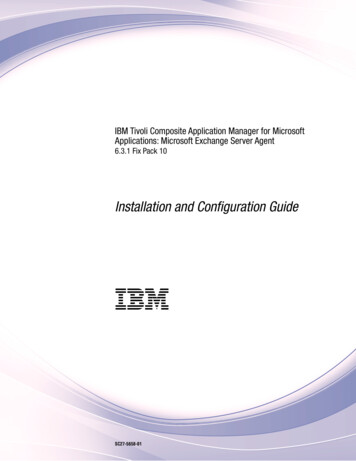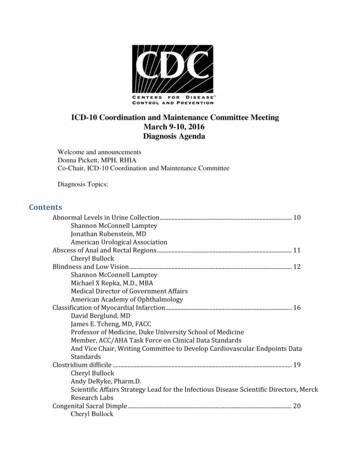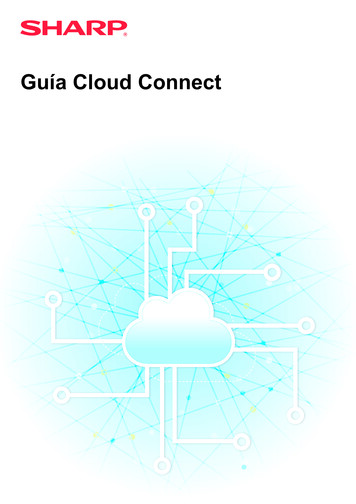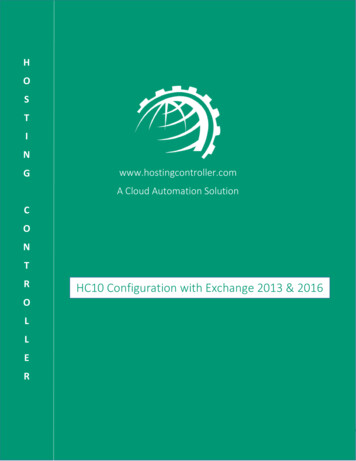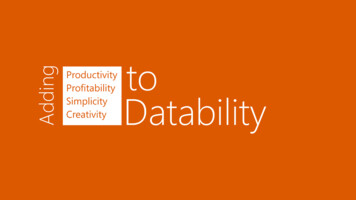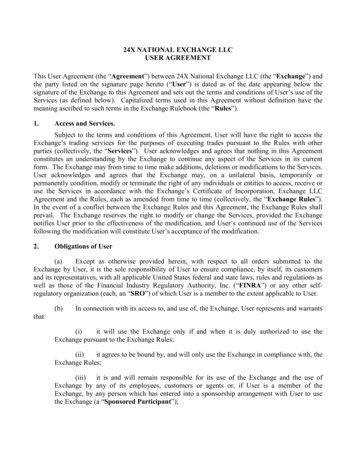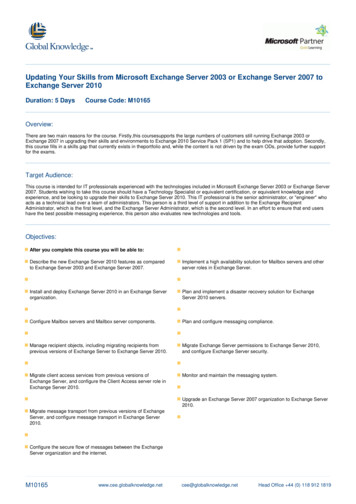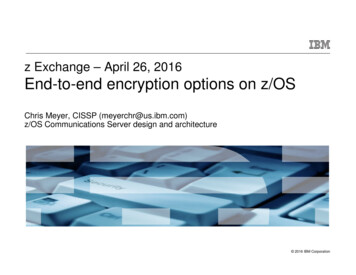
Transcription
z Exchange – April 26, 2016End-to-end encryption options on z/OSChris Meyer, CISSP (meyerchr@us.ibm.com)z/OS Communications Server design and architecture 2016 IBM Corporation
Trademarks, notices, and disclaimersRefer to www.ibm.com/legal/us for further legal information.The following terms are trademarks or registered trademarks of International Business Machines Corporation in the United States or other countries or both: Advanced Peer-to-PeerNetworking AIX alphaWorks AnyNet AS/400 BladeCenter Candle CICS DataPower DB2 Connect DB2 DRDA e-business on demand e-business (logo) e business(logo) ESCON FICON GDDM GDPS Geographically DispersedParallel SysplexHiperSocketsHPR Channel ConnectivityHyperSwapi5/OS (logo)i5/OS IBM eServerIBM (logo) IBM IBM zEnterprise SystemIMSInfiniBand IP PrintWay IPDSiSeriesLANDP Language Environment MQSeries MVSNetView OMEGAMON Open PowerOpenPowerOperating System/2 Operating System/400 OS/2 OS/390 OS/400 Parallel Sysplex POWER POWER7 PowerVMPR/SMpSeries RACF Rational Suite Rational RedbooksRedbooks (logo)Sysplex Timer System i5System p5System x System z System z9 System z10Tivoli (logo) Tivoli VTAM WebSphere xSeries z10 z13 zEnterprise zSeries z Systems z/Architecturez/OS z/VM z/VSE* All other products may betrademarks or registeredtrademarks of theirrespective companies.The following terms are trademarks or registered trademarks of International Business Machines Corporation in the United States or other countries or both: Adobe, the Adobe logo, PostScript, and the PostScript logo are either registered trademarks or trademarks of Adobe Systems Incorporated in the United States, and/or other countries. Cell Broadband Engine is a trademark of Sony Computer Entertainment, Inc. in the United States, other countries, or both and is used under license there from. Java and all Java-based trademarks are trademarks of Sun Microsystems, Inc. in the United States, other countries, or both. Microsoft, Windows, Windows NT, and the Windows logo are trademarks of Microsoft Corporation in the United States, other countries, or both. InfiniBand is a trademark and service mark of the InfiniBand Trade Association. Intel, Intel logo, Intel Inside, Intel Inside logo, Intel Centrino, Intel Centrino logo, Celeron, Intel Xeon, Intel SpeedStep, Itanium, and Pentium are trademarks or registered trademarks of IntelCorporation or its subsidiaries in the United States and other countries. UNIX is a registered trademark of The Open Group in the United States and other countries. Linux is a registered trademark of Linus Torvalds in the United States, other countries, or both. ITIL is a registered trademark, and a registered community trademark of the Office of Government Commerce, and is registered in the U.S. Patent and Trademark Office. IT Infrastructure Library is a registered trademark of the Central Computer and Telecommunications Agency, which is now part of the Office of Government Commerce.Notes: Performance is in Internal Throughput Rate (ITR) ratio based on measurements and projections using standard IBM benchmarks in a controlled environment. The actual throughput that anyuser will experience will vary depending upon considerations such as the amount of multiprogramming in the user's job stream, the I/O configuration, the storage configuration, and the workloadprocessed. Therefore, no assurance can be given that an individual user will achieve throughput improvements equivalent to the performance ratios stated here. IBM hardware products are manufactured from new parts, or new and serviceable used parts. Regardless, our warranty terms apply. All customer examples cited or described in this presentation are presented as illustrations of the manner in which some customers have used IBM products and the results they may haveachieved. Actual environmental costs and performance characteristics will vary depending on individual customer configurations and conditions. This publication was produced in the United States. IBM may not offer the products, services or features discussed in this document in other countries, and the information may be subject tochange without notice. Consult your local IBM business contact for information on the product or services available in your area. All statements regarding IBM's future direction and intent are subject to change or withdrawal without notice, and represent goals and objectives only. Information about non-IBM products is obtained from the manufacturers of those products or their published announcements. IBM has not tested those products and cannot confirm theperformance, compatibility, or any other claims related to non-IBM products. Questions on the capabilities of non-IBM products should be addressed to the suppliers of those products. Prices subject to change without notice. Contact your IBM representative or Business Partner for the most current pricing in your geography.2 2016 IBM Corporation
Agenda What is end-to-end security? Network security protocols– The protocols Transport Layer Security (TLS, also known as SSL) IPsec Secure Shell (SSH)– z/OS implementation options– Considerations for each option Protecting z/OS traffic– Common z/OS traffic types TN3270 Enterprise Extender (EE) FTP SFTP (SSH file transfer) Connect:Direct (aka NDM) CSSMTPCICSMQIMS ConnectDB2NJE HTTP WebSphereDNSNFS, PortmapperlpdICMP– Alternatives for protecting each3 2016 IBM Corporation
Agenda What is end-to-end security? Network security protocols– The protocols Transport Layer Security (TLS, also known as SSL) IPsec Secure Shell (SSH)– z/OS implementation options– Considerations for each option Protecting z/OS traffic– Common z/OS traffic types TN3270 Enterprise Extender (EE) FTP SFTP (SSH file transfer) Connect:Direct (aka NDM) CSSMTPCICSMQIMS ConnectDB2NJE HTTP WebSphereDNSNFS, PortmapperlpdICMP– Alternatives for protecting each4 2016 IBM Corporation
End-to-end security Branchbut where is the SecureDESecureSecureSecureSecureFSecured segmentPartner authenticationKey managementMessage authentication and integrityA No securityNoneNoneNoneB WAN onlyTwo WAN routersOn WAN routersBetween WAN routersC Branch WANWorkstation – WAN router 2On workstation and WAN router 2Between workstation and WAN router 2D WAN data centerWAN router 1 – z/OSOn WAN router 1 and z/OSBetween WAN router 1 and z/OSE Hop-by-hop securityHop by hopOn all nodes, including WAN routersBetween all nodes, but not end to end (performance hit)F End-to-end securityWorkstation – z/OSWorkstation and z/OSBetween workstation and z/OS5 2016 IBM Corporation
Agenda What is end-to-end security? Network security protocols– The protocols Transport Layer Security (TLS, also known as SSL) IPsec Secure Shell (SSH)– z/OS implementation options– Considerations for each option Protecting z/OS traffic– Common z/OS traffic types TN3270 Enterprise Extender (EE) FTP SFTP (SSH file transfer) Connect:Direct (aka NDM) CSSMTPCICSMQIMS ConnectDB2NJE HTTP WebSphereDNSNFS, PortmapperlpdICMP– Alternatives for protecting each6 2016 IBM Corporation
Protocols: The four big questionsHello, I am Mr. Smith and I want toestablish a secure communicationchannel with my bank!I am Mr. SmithI am Mr. Smith’s bankHere is a securemessage to you!Who are you? (Partner authentication) How do I know that you really are whoyou claim to be and not someimposter? How do you know that I am who I say Iam?Where did this message come from?(Message authentication) How do I know the secure messageactually came from the partner Iauthenticated a little earlier? How do I know it wasn’t injected intothe network by someone else?Did anyone change this message?(Message integrity) How do I know that someone didn’tmodify the message since you sent it? How do I know that someone didn’tduplicate an otherwise valid message?Each of the secure network communications protocols addressthese four basic questions, but in slightly different ways7Can anyone else read this message?(Data Confidentiality) How do I know that no one could haveintercepted this message and read it inan intelligible way when it wastraversing the network? 2016 IBM Corporation
Protocols: z/OS Technology overviewz/OSssh, sftp, ew,OMEGAMON, DB2,CIMOM, RACF, FTP,TN3270, IMS,JES/NJE, CICSSockets, 3rd party,any customer TCPapplicationAnyapplication orsubsystem –including EEand otherUDP-basedapplicationsSystem SSL e is morethan one way tosecure networktraffic in and outof nBut rememberthat bothendpoints mustsupport the samesecurity protocol!IPsecenabledsystems 2016 IBM Corporation
Protocols: What’s encrypted and how are packet inspecting devices affected? What are “packet inspecting devices?”– Many firewalls (especially those that are stateful)– Intrusion detection devices (signature-based)– Contents-based routers– Protocol analyzers, tracers (sniffers), debuggers, etc.Noencryption:WSSencryption:I am a packet inspectingdevice who wants to inspectthose IP packets 8.1.15000180POST / HTTP/1.1 . soapenv:Envelope .SrcIPDestIPSrcPortDestPortData80POST / HTTP/1.1 . soapenv:Envelope . xenc:EncryptedData .192.168.100.1192.168.1.150001 % ##%%%%SSH PortDestPortData192.168.100.1192.168.1.150002443@% #*&& !:"J)*GVM .1.1 ::"*&hU @% #dd*&& s !:"J)*bGVM (*hhgvvv IP header encryption varies based on transport/tunnel mode, and AH/ESP protocol9YournetworkengineerYoursecurityczar 2016 IBM Corporation
Secure Shell (SSH)TCP connection1SSH client program initiates a TCPconnection to the SSH server. Onceconnected, a handshake occurs toauthenticate the server and client to eachother, negotiate cryptographic algorithmsto use and exchange session keys.SSHclientHandshake messagesSSHserverUpon successful completion of thehandshake, a secure connection existsbetween the client and the server.210Data “channels” (e.g., login, sftp, scp,port forwarding etc.) are created andmutiplexed under protection of thesecure connection using symmetricencryption and message authenticationnegotiated during handshakeSSHclientSSH connectionSSHserverData flows through channels protected by SSH connection 2016 IBM Corporation
SSH componentryTCP/IPApplication Application-layer– SSH and its applications run completely at the applicationlayer.– Even with port forwarding, traffic must pass through theSSH process in user space for encryption/decryptionbefore it’s forwarded to its ultimate destinationscpSSH clientSockets APIencrypted One SSH connection, multiple “channels”– Each channel is a separate application stream (i.e.,remote terminal, port forwarding, etc.)– However, in the most common case, command-line utilites(sftp, scp) invoke the SSH client such that a dedicatedSSH connection is established for use by that command.sftpTransport (TCP)NetworkingIPv4, IPv6DLC11 2016 IBM Corporation
SSH on z/OS In general, SSH on z/OS is used for remote access and file transfer between z/OS and *IXsystems. Because of this, we will focus mainly on TLS and IPsec Though available, TCP port forwarding is not heavily used on z/OS:– every packet must pass to the SSH application for encryption/decryption before being forwarded to itsultimate destination– not a very scalable solution IBM offers an OpenSSH implementation–––––V2R1 and earlier – part of IBM Ported Tools for z/OSV2R2 – part of z/OS propersupports CPACF (via ICSF), hardware random number generation and SAF keyrings for private keysdoes not support MVS datasets or X.509 certificatesin V2R2: FIPS 140-2 mode, Kerberos authentication and key exchange, zEnterprise DataCompression hardware support There are also some 3rd party SSH products that provide a some of the features that are notavailable in the z/OS OpenSSH implementation12 2016 IBM Corporation
Transport Layer Security (and Secure Sockets Layer)Definitions:SSL Secure Sockets Layer (an invention of Netscape). Final version was SSLv3.TLS Transport Layer Security (the IETF standardized version of SSL). TLS 1.0 isbased on SSLv3.For our purposes, SSL and TLS are equivalent and one term implies the otherTCP connection1Client application initiates TLS handshakewhich authenticates the server (and,optionally, client) and negotiates a ciphersuite to be used to protect dataappl(client)Handshake messagesappl(server)Upon successful completion of thehandshake, a secure TLS session existsfor the application partners213Data flows through secure session usingsymmetric encryption and messageauthentication negotiated duringhandshakeappl(client)TLS sessionappl(server)Data flows through secure TLS session 2016 IBM Corporation
Traditional TLS componentryTCP/IPApplication Application-layer– The TCP application must call TLS functions to performthe handshake and later to protect each applicationmessage– In order to add protection to an existing application, thatapplication must be modified (business logic, config, etc.)– On z/OS, System SSL and the Java JSSE provide the TLSfunctionsSockets APIencrypted One connection, one TLS session*– Each application maintains its own TLS sessions– Some implementations support “session reuse” to gainefficiency in the number of handshakes, but typically, aTLS session is associated with a single applicationconnectionTLS/SSLTransport (TCP)NetworkingIPv4, IPv6DLC* in most cases!14 2016 IBM Corporation
z/OS Application Transparent TLS IP stack-based TLS– TLS process performed in TCP layer (via System SSL)without requiring any application change (transparent)– AT-TLS policy specifies which TCP traffic is to be TLSprotected based on a variety of criteriaAT-TLSpolicy z/OS userid, jobname Time, day, week, monthTCP/IPApplication Application transparency– Can be fully transparent to application– An optional API allows applications to inspect or controlcertain aspects of AT-TLS processing – “applicationaware” and “application-controlled” AT-TLS, respectively Supports standard configurations– z/OS as a client or as a server– Server authentication (server identifies self to client)– Client authentication (both ends identify selves to other)Transport (TCP)AT-TLSSystem SSLencrypted Available to TCP applications– Includes CICS Sockets– Supports all programming languages except PASCALSockets APIz/OS CS Policyinfrastructure Local address, port Remote address, port Connection directionAT-TLS orkingIPv4, IPv6DLC Uses System SSL for TLS protocol processing– Remote endpoint sees an RFC-compliant implementation– Interoperates with other compliant implementations15 2016 IBM Corporation
Advantages of using AT-TLS Reduce costs– Application development Cost of System SSL integration Cost of application’s TLS-related configuration support– Consistent TLS administration across z/OS applications– Gain access to new features with little or no incrementaldevelopment cost Complete and up-to-date exploitation of System SSL features– AT-TLS makes the vast majority of System SSL features available toapplications. For example, V2R2 OCSP support and HTTP CRL retrieval V2R1 TLSv1.2 support– AT-TLS keeps up with System SSL enhancements – as new features areadded, your applications can use them by changing AT-TLS policy, notcode Ongoing performance improvementsFocus on efficiency in use of System SSL Great choice if you haven’t already invested in System SSL integrationEven if you have, consider the long-term cost of keeping up vs. short termcost of conversion16 2016 IBM Corporation
IPSec using Internet Key Exchange (IKE)1IKE peers negotiate an IKE (“phase 1”)tunnel (one bidirectional SA) over anunprotected UDP socket. RSA, DSA or ECDSA signatures for peer authentication Diffie-Hellman based symmetric key generation2IKE peers negotiate IPSec (“phase 2”)tunnel (two unidirectional SAs) underprotection of the IKE tunnel DES, 3DES or AES encryption of IKE messages MD5 or SHA-1 MACing for IKE message authentication SHA-2 or AES-based MACing for IKE message authentication3Data flows through IPSec tunnel usingAuthentication Header (AH) and/orEncapsulating Security Payload (ESP)protocol DES, 3DES or AES encryption of ESP packets MD5 or SHA-1 MACing for AH and ESP packet authentication SHA-2 or AES-based MACing for AH and ESP packet authentication17 2016 IBM Corporation
IPsec components and basic interactionsApplicationIKED“phase 1” or “IKE” SAIKEDSockets APISockets APITransport (TCP)Transport (TCP)Networking (IP)Networking (IP)431Application2SADIPsec(ESP, AH)SPDIP filters55IPsec(ESP, AH)SAD3IP filtersSPD1“phase 2” or “child” SAsDLC18DLC 2016 IBM Corporation
IPSec use of System z Integrated Information Processor (zIIP) The zIIP assisted IPSec function is designed to move most of the IPSec processing from thegeneral purpose processors to the zIIPs z/OS CS TCP/IP recognizes IPSec packets and routes a portion of them to an independentenclave SRB – this workload is eligible for the zIIP– Inbound operation (not initiated by z/OS) All inbound IPSec processing is dispatched toenclave SRBs and is eligible for zIIP All subsequent outbound IPSec responses fromz/OS are dispatched to enclave SRB. This meansthat all encryption/decryption of message integrityand IPSec header processing is sent to zIIP– Outbound operation (initiated by z/OS) Operation which starts on a TCB is not zIIP eligible BUT any inbound response or acknowledgementis SRB-based and therefore zIIP eligible AND all subsequent outbound IPSec responsesfrom z/OS are also zIIP eligible19Sourcez/OS zIIP Sourcez/OS zIIP Sinkz/OS zIIPSinkz/OS zIIPSinkz/OS zIIP IPSecIPSec 2016 IBM Corporation
What about performance?FTP Server CPU usage with and without securityTotal Server CPU Utilization %150128 connections100zIIP processor“pegged”32 connections500050100Throughput (MB)Clear TextAT-TLSIPSec without zIIPsIPSec with zIIPsAll measurements done with z/OS V1R12Outbound Data (Gets) to an MVS client3DES encryption with SHA authenticationFrom 1 to 128 parallel connectionsHighest throughput numbers obtained with 0 think-timeClient: 1 z10 LPAR (3 dedicated CPs)Server: 1 z10 LPAR (4 dedicated CPs)Connectivity: OSA-E3 10 GbEEncryption/Authentication: 3DES/SHATransaction: 1 byte / 2 MBTarget data sets: MVS data sets on 3390 DASDThink time: 1500 msNumber of connections: 1 to 128Driver tool: AWMAll performance data contained in this publication was obtained in the specific operating environment and under the conditions described and is presented as anillustration. Performance obtained in other operating environments may vary and customers should conduct their own testing.20 2016 IBM Corporation
Configuration Assistant: Reusable object modelGroup IP addresses that need thesame treatment. For example allVIPA addresses, or all real networkinterface addresses. Simplifiescreation of connectivity rulesIP Address groupIdentifies a specific type ofapplication network traffic. Basedon protocol , local and/or remoteports, connection direction, z/OSjobname, useridIdentifies the TLS/SSLsecurity requirements,such as ciphersuites,allowed protocol versions(e.g. SSLv3, TLSv1), etc.Traffic DescriptorSecurity LevelIP AddressIP AddressRequirement MapIP AddressIP AddressConnectivity RulePer policy type (not allobject types are used withall policy types)Identifies whattype of AT-TLSsecurity appliedto your trafficdescriptorsConnectivity rules tie IPaddresses to requirement mapsLPARs (Images)Stacks1. Create system image and TCP/IP stack image2. Create one or more Requirement Maps to define desired security for common scenarios (e.g. intranet,branch office, business partner)– Create or reuse Security Levels to define security actions– Create or reuse Traffic descriptors to define application ports to secure3. Create one or more Connectivity Rules between Data Endpoints (IP addresses) and associate with aconfigured Requirement Map21 2016 IBM Corporation
Configuring IPsec and AT-TLS on z/OS: Configuration Assistant22 2016 IBM Corporation
Configuration Assistant: AT-TLS stack view23 2016 IBM Corporation
Comparing TLS, IPsec* and SSH protocolsAttributeTLS (SSL)IPsecSSH-2Traffic coveredTCP connectionsAll IP traffic (TCP, UDP,ICMP, etc.)TCP connectionsProvides true end-to-endprotectionYesYesYesProvides network segmentprotectionNoYesNoProtection scopeSingle TCP connectionFlexible (all traffic, singleprotocol, single or range ofconnections, etc.)One or more TCPsessionsRequires application layerchangesYes (except basic AT-TLS)NoNoEndpoints and authenticationApplication to applicationIP node to IP nodeHost to HostAuth credentialsX.509 certificates(dynamic tunnels only)X.509 certificates or preshared keyspublic/private key,OpenSSH certificatesAuth frequencyConfigurableConfigurableOnce at session startupSession key refreshConfigurable based ontimeConfigurable based on dataand timeConfigurable based ondata* - using IKE to establish IPsec tunnels dynamically24 2016 IBM Corporation
Comparing TLS, IPsec and SSH implementations on z/OSAttributeTLS (SSL)IPsecSSH-2ConfigurationAT-TLS: PolicySystem SSL direct: perapplicationJSSE: Java propertiesPolicyOpenSSH configurationfiles as well as oncommand line invocationApplication transparencyAT-TLS: Yes*System SSL direct: NoJSSE: NoYesCan be with portforwardingSAF KeyringsYesYesYes (keys only)Secure Keys (CryptoExpress)YesYesNoFIPS 140-2 modeYesYesYes (new in V2R2)Specialty engine supportAT-TLS and System SSLdirect: NoJSSE: YesYesNoSystem z hardware cryptoCPACF, CryptoExpressCPACF, CryptoExpressCPACF, CryptoExpress(RNG)* - can be as transparent as the application wants it to be25 2016 IBM Corporation
Some considerations in selecting a security protocol (1 of 2)1. Does corporate security policy dictate a specific technology or requirement? Technology example: “All file transfers must be protected by TLS version x.x” Requirement example: “All customer financial data must be encrypted, end-to-end, as it traversesthe network”2. What are the capabilities of the hosts and network equipment? Both endpoints of asecure connection must support the same Network security protocols and versions Cryptographic algorithms and key lengths3. How do your company’s firewall , deep packet inspection and network security policies fitin with the options? Can you use the protocol within the firewall policies? How will encryption affect your deep packet inspection devices (IDS/IPS, etc.)? Are you using NATs? If so, look closely at the way you want to use IPsec4. What is your communication partner willing to use? Different enterprises have different standards and infrastructure(e.g., you may use IPsec, but they may not) Many *IX users won’t touch anything but SSH for file transfer5. Are relative security infrastructures already in place?26 Is there already an Public Key Infrastructure (PKI) in place? Is TLS or IPSec already deployed anywhere in the network? What method will you use to distribute public keys for SSH? 2016 IBM Corporation
Some considerations in selecting a security protocol (2 of 2)6. Do the security protocols support the transport protocols? TLS works great for TCP, but nothing else IPSec protects any IP traffic, regardless of transport protocol7. Is the application already enabled for network security? TLS-enabled applications may offer features based on the TLS integration If not, consider application-transparent technologies8. What do you want to authenticate? Application/user identity (TLS authentication is visible to the application, IPSec isnot) Host identity (IPSec authenticates at the host level)9. How are the different technologies implemented on the platformsinvolved? Performance optimization: Hardware crypto and otheracceleration technologies Exploitation of other platform-specific features (secure key,SAF, etc.)10. There will be others27 2016 IBM Corporation
Agenda What is end-to-end security? Network security protocols– The protocols Transport Layer Security (TLS, also known as SSL) IPsec Secure Shell (SSH)– z/OS implementation options– Considerations for each option Protecting z/OS traffic– Common z/OS traffic types TN3270 Enterprise Extender (EE) FTP SFTP (SSH file transfer) Connect:Direct (aka NDM) CSSMTPCICSMQIMS ConnectDB2NJE HTTP WebSphereDNSNFS, PortmapperlpdICMP– Alternatives for protecting each28 2016 IBM Corporation
TN3270 Tight integration with AT-TLS– TN3270 is an AT-TLS-controlling or -aware application (depending on setting of CONNTYPEparameter)– Provides access to the latest features of System SSL– Tested with tens/hundreds of thousands of concurrent connections– CONNTYPE supports a few modes in how TLS protection is applied: SECURE – use TLS immediately at client connect time NEGTSECURE – use a TN3270 negotiation with client to see if client is willing to use TLSprotection. If not, the connection is closed. ANY – Try the TLS handshake – if the client doesn’t support it, allow the cleartext connnection BASIC – no security, just cleartext NONE – don’t allow any client connections– There’s also a deprecated direct integration with System SSL - no longer being updated and is notrecommended IPsec is also an option– In this case, TN3270 “thinks” it’s running in cleartext mode– Traffic is secure, but you won’t have visibility to client certificates through usual TN-related displays– Provides the benefit of zIIP offload29 2016 IBM Corporation
Configuring TN3270 to use AT-TLS TN3270 and FTPTN3270 and FTPApplication-specificSSL/TLS supportApplication-specificSSL/TLS supportSSL/TLSsecurityoptions 30SSL/TLSsecurityoptions TN3270-specific security options:– SECUREPORT (use of this option willindicate to TN3270 that it is to use its existingapplication-specific TLS/SSL support, and notAT-TLS for the specified port number)– CONNTYPEo SECUREo NEGTSECUREo ANYo BASIC– EXPRESSLOGON– RESTRICTAPPL CERTAUTH TN3270 TLS/SSL security options– KEYRING– CRLLDAPSERVER– CLIENTAUTHo SSLCERTo SAFCERT– ENCRYPTION– SSLTIMEOUT– SSLV2/SSLNOV2AT-TLSTo specify whether TN3270 should use AT-TLS instead of the TN3270 server'sown system SSL calls , use the following TN3270 configuration parameter:– TTLSPORT CONNTYPE retains its current meaning for a TTLSPORTWhen TTLSPORT is used for a TN3270 server port:– The TN3270 server becomes an AT-TLS controlling and AT-TLS awareapplication– All the TN3270-specific security options will continue to impact how TN3270operates– Any TN3270 server TLS/SSL security options will be ignored. Matching AT-TLS policies need to be defined before enabling AT-TLSsupport for the TN3270 server 2016 IBM Corporation
z/OS V1R9 Communications Server TN3270E AT-TLS Security Performance(TN3270 Server, Steady State, CPU per Transaction)Total CPUpertransaction(CICS, DB2,application,etc.)IPv4 TN3270E Server CPU Scalabilityz/OS CS V1R9 AT-TLS vs. Clear Text2 TN servers with 1 Port each400MicrosecondsServer CPU per Transaction500300200TN3270 server CPU pertransaction100 08000160003200064000128000256000Number of TN3270E sessionsTN3270 server and application server: 4-way 2094-S38 The TN3270 server CPU portion of thetotal CPU usage per transaction is verysmall.If you increase the TN3270 server CPUusage with 20%, the total transactionpercentage CPU increase is significantlylower.3DES and SHA100 bytes in/800 bytes outThink time 30 seconds31 2016 IBM Corporation
Detailed AT-TLS netstat report for AT-TLS secured TN3270 connectionNETSTAT TTLS CO 000016AF DETAIL TCP TCPCSConnID: 000016AFJobName:TN3270ALocalSocket: ::ffff:9.42.105.45.2025RemoteSocket: ::ffff:9.65.253.59.1266SecLevel:TLS Version 1Cipher:0A TLS RSA WITH 3DES EDE CBC e: ABC TN3270-Server 2025 :AllRemotePortFrom: 1024RemotePortTo: 65535Direction:InboundTTLSGrpAction: emonSecondaryMap:OffFIPS140:Off32TTLSEnvAction: lidationMode:AnyTTLSConnAction: cAct3 TN3270 2025HandshakeRole:ServerV3CipherSuites:2F TLS RSA WITH AES 128 CBC SHA0A TLS RSA WITH 3DES EDE CBC :OnSecondaryMap:Off 2016 IBM Corporation
Enterprise Extender Since EE uses UDP/IP, TLS/SSL is not a viable option IPsec is used heavily and very successfully in the industry for protecting EE traffic As with all applications, IPsec is completely transparent to EE traffic Configuration can be very narrow – down to the specific EE ports if so desired EE over IPsec performance has seen dramatic improvements in past releases. Examples:– Improved performance for EE over IPSec The “bursty” nature of HPR traffic can cause significant performance degradation when it iscarried over IPSec tunnels.Smaller bursts frequently get encrypted and sent before larger bursts. This results in out-oforder segments that are dropped at the other end of the IPSec tunnel, forcing retransmits. V1R11 breaks large bursts into batches of smaller bursts PTFed back to V1R10 – APAR PK93190– Improved support for EE over IP
(sftp, scp) invoke the SSH client such that a dedicated SSH connection is established for use by that command. SSH client . In general, SSH on z/OS is used for remote access and file transfer between z/OS and *IX systems. Because of this, we will focus mainly on TLS and IPsec Though available, TCP port forwarding is not heavily used on z/OS:


